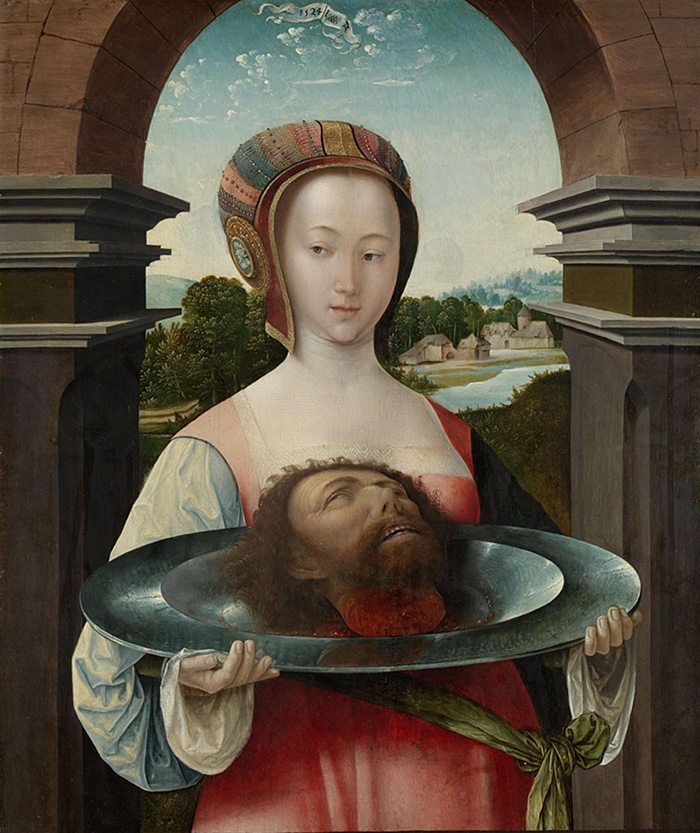Herodias: Bad Momma

Heads up! (Or, unfortunately, heads off…)
One of the most evil women in biblical history shows up in the lectionary (Proper 10, Year B) this Sunday. Her name is Herodias; she’s married to the terroristic Herod, and she is the catalyst for the head of John the Baptist winding up on a platter. She is bloodthirsty, vengeful, selfish, ruthless—and a really bad mother.
Amazingly—and tragically—the words spoken between Herodias and her daughter represent the only full conversation between a mother and daughter in the entire Bible.*
_____________
Think of yourself living in first-century Palestine. Here’s the way it looks at the palace:
Herodias is married to Herod Antipas, the ruler of Galilee. Herodias has been cradled in malevolence since her early days, as it was her grandfather, Herod Agrippa 1, who ordered the slaughter of the Holy Innocents after Jesus was born.
Herodias’ daughter is Salome, thus Herod Antipas is Salome’s stepfather. Her biological father is Herod Philip, Herodias’ uncle and first husband. He would still be married to Herodias had not she and Antipas rejected their first spouses for each other.
Enter John the Baptist, criticizing Herod loudly and publicly for his adulterous and incestuous ways. So incensed is Herodias by John’s shaming of Herod (and her) that she wants John dead, ASAP! When a birthday party is thrown by Herod to celebrate his birthday, the perfect opportunity arises.
Suffice it to say that much wine was available. And so was, apparently, a love of dance. Salome so mesmerizes Herod as she dances for his guests that he promises to give the girl anything she desires. Salome runs to Mama, asking her opinion.
“Get the head of John the Baptist!” hisses Herodias. So Salome runs back to her (apparently) drunk stepfather, echoing her mother’s demand. “I want you to give me the head of John the Baptist on a platter! Now!”
And off came John’s head.
The one who had lit the way for Jesus since before his birth was suddenly gone, felled by the murderous actions of a girl and her mother.
Consider this
The Bible itself does not give much detail on Salome: not her age, nor the level of complicity in this gristly tale. Her involvement, then, takes one of three paths:
Possibility #1: A precocious little girl pleasing her mother, dancing to entertain her stepfather, the king. Obediently doing what her mother instructed, she may have been unaware of the distress between John the Baptist and her parents.
Possibility #2: Salome is older, perhaps an adolescent, and she dances provocatively, shedding one veil after another, playing off Herod’s (presumed) attraction to her. A disturbing image of budding sexuality misused.
Possibility #3: Mother planned the event, and sent her daughter in to dance, accurately gauging her husband’s response.
Herodias was indeed the active force in separating John the Baptist’s head from his body. And it remains staggering to ponder that this is the only full mother-daughter conversation in the entire Bible.
Something to keep in mind: this Sunday’s Epistle reading (Ephesians 1:3-14) provides constructive thoughts on the child/parent relationship, saying that those who are sealed in Christ through baptism are “destined for adoption as God’s children through Jesus Christ.”
St. Paul also adds: “In Christ we have also obtained an inheritance toward redemption as God’s own people.”
And then there’s the plumb line analogy from Amos in the Old Testament reading. Maybe that’s the first job of a parent: holding the line, setting a straight path, pointing to the One at the center of it all.
Shorthand: Our earthly parents may fail us—and terribly fail us, as was demonstrated by Herodias, one of the worst mothers in history. Yet as God’s children, we are offered a path of wholeness and redemption. And thanks be to God for that path–that sacred, restorative and eternal straight path.
___________
*There’s a conversation between Rebekah and her mother in Genesis 24;58, but her brother was speaking the same words as her mother.
Text: Adapted from Bible Women: All Their Words and Why They Matter. Author: Lindsay Hardin Freeman. Publisher: Forward Movement.
Art: Salome met het hoofd van Johannes de Doper, Jacob Cornelisz. van Oostsanen, 1524, public domain

